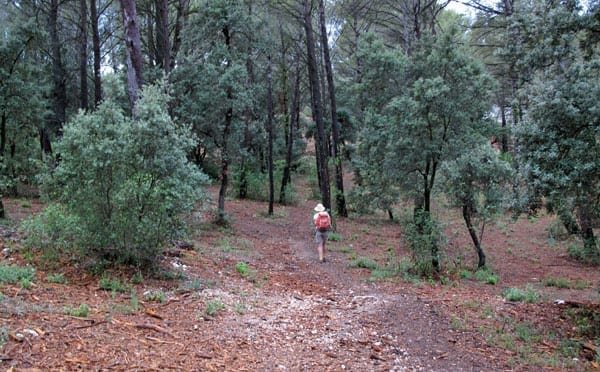
Monday, 2 July 2012
Distance 33 km
Duration 7 hours 45 minutes
Ascent 104 m, descent 151 m
Map 171 of the TOP100 lime-green series
During the night it continued to rain copiously, but stopped in time for us to pack up unhindered.
Once again my washing had been blown off the clothes line and all my walking clothes were saturated, so I stuffed them into a plastic bag and spent the day in evening clothes, not that anyone noticed.
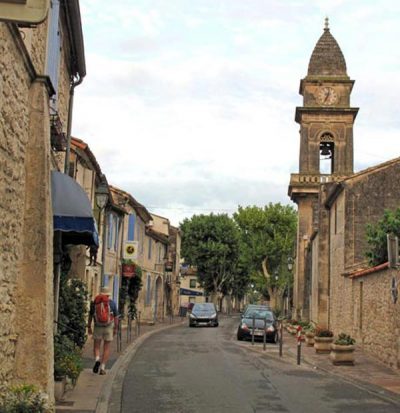
Outside the camping fence we picked up a line of GR marks on the trunks of the pine trees, which we thought would lead us out of town, but they did the reverse, which turned out to be no bad thing.
We found ourselves going down a walled lane and into the main street, where we were glad to see the bar on the corner already full of people. It was market day, although too early for customers, and the stalls were being set up in the rain-washed square.
After a brief coffee we set off along the D33, still on the GR marks, for a kilometre or so until we came to the mill of Alphonse Daudet, the nineteenth-century novelist whose most famous work, Lettres de Mon Moulin, concerned this exact mill.
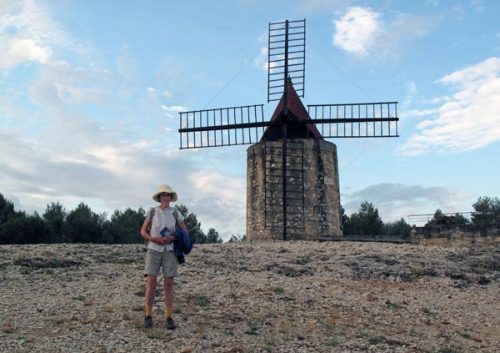
It stood on a scoured rocky rise with its great empty sails and conical cap etched evocatively against the sky. Here we left the road and followed the little red and white markers into the trees.
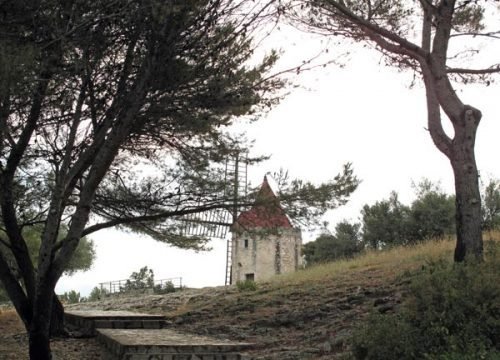
For a while it seemed as if we were once again being taken back into the village, but then the track turned and we came out of the forest into open country.

Before this little road reached the highway (the D17), we left the GR and made our own way on a series of tracks through dead flat marshland, which was threaded with reedy canals.
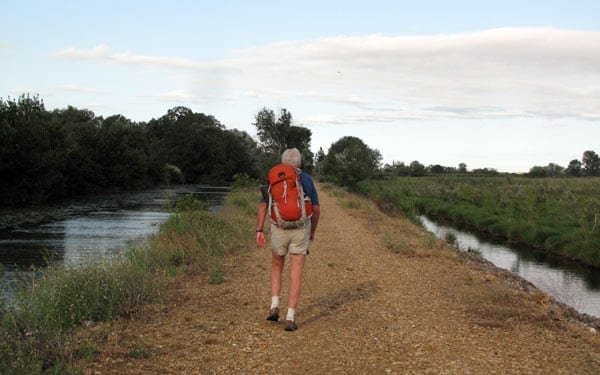
A couple of times we found ourselves on the wrong side of a canal with no way across and had to deviate considerably, but eventually we came to a bitumen road.
This took us towards the highway, which we traversed through a low underpass for walkers only, and so we entered Arles.

Soon after that we crossed the highway through a low underpass for walkers only, and so we entered Arles.
The centre of Arles is a very fine old town with admirable standing monuments from Roman times and later, but it was hard to appreciate these things in the company of so many hard-faced tour operators and their flocks.
There were gift shops everywhere, and many bars, a circumstance that we normally approve of, but we were put off by the jaded, cynical looks on the faces of the waiters. Like the shop-owners in Montmartre, they had seen too many tourists.
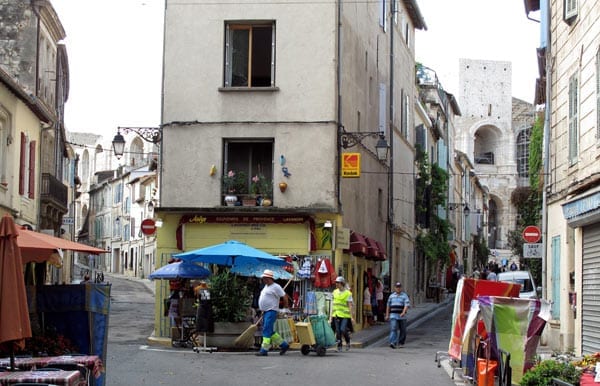
However, we sat down and had coffee, with a sample of the baguette that we had just bought.
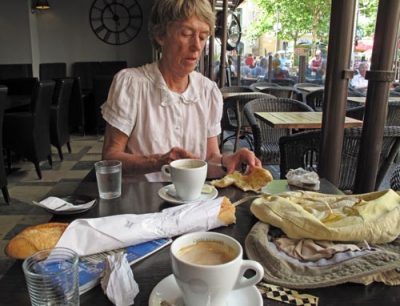
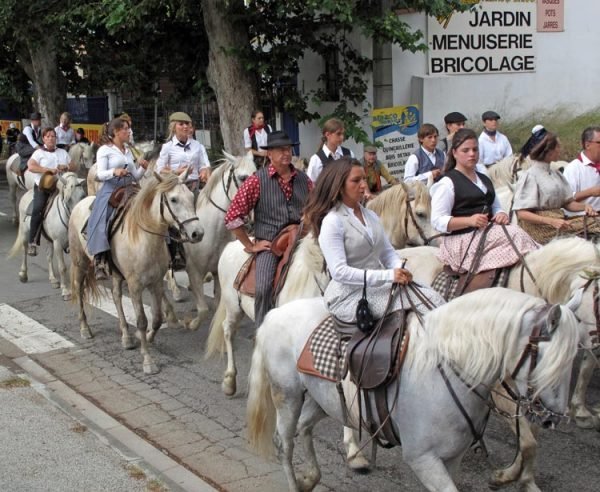
Setting off refreshed at about 11 am, we crossed the huge Rhône river, following the GR marks, and turned left onto a tree-lined street along the right bank. Before long we came to a barricade and were told to get off the road.
The reason soon became clear – a long procession of Camargue horses was coming into town.
Most of the horses were white and most of the riders were in traditional dress. There were a couple of horse-drawn carriages and even some ancient bicycles in the parade, the reason for which we never found out.
At a roundabout we turned off on the road to Gimeaux, away from the river and into the Camargue proper.

The road was narrow and patched, with watery ditches on either side, lined with tall reeds. The only trees were stunted tamarisks, whose feathery foliage offered little shade, and there was none at all on the road itself. We passed orchards and vineyards, and later, as the land became poorer, occasional groups of black bulls or white horses, both of which are characteristic of the Camargue.
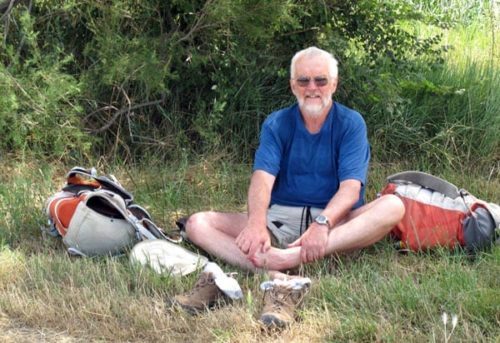
It was hot work in the full sun but we could not complain about unnecessary deviations – the road stretched far ahead with hardly a bend or a rise.
After an hour of this we found a tamarisk tree that was casting a meagre pool of shade onto the roadside, and took the chance to sit down, take off our boots and have lunch, consisting of half a baguette from Arles with some sausage and cheese and a great deal of water.
While we were sitting there the only traffic that passed by was a long-distance cyclist, a garbage truck and a sulky drawn by a pair of chestnut horses. The occupants of the sulky were still in period costume, evidently returning from the parade in Arles.

Another hour of walking brought us to a bend in the road, and then it seemed to take an age to reach the highway, which we crossed and then rejoined as it went over the Petit Rhône on a modern concrete bridge. Even from there it was quite a step into the town of St-Gilles, or so it seemed to us in our dusty, sweaty, weary state.
At the entrance to the town there was another bridge, this time over the Rhône-Sète canal. Pleasure boats were drawn up along the bank and we could see a promising looking eatery on the corner.
Keeping it in mind for this evening, we went straight on into the centre, where there were a couple of bars side by side under a fine old Provençal pine. By this time it was 3:30 pm and things were pretty quiet in town.
From where we sat with our cold beer and water, we could see a large banner across the main street, advertising the camping ground 100 metres down the side street, a very pleasing sight.
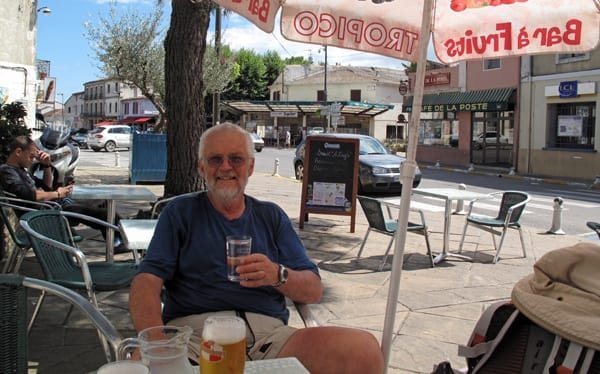
There was of course nobody in the office of the camping ground, so we chose a little hedged plot with a vine-covered arched enclosure at the back (for what purpose we did not find out) and set ourselves up on the bare ground, as there was no grass.
However, it was quite comfortable on our sleeping mats in the shade of the hedge, the only drawback being a few mosquitoes who whined annoyingly. It is rare to be troubled by insects of any kind in France, but the Camargue is such a marsh that it was not really surprising.

At 7:30 pm we set off to look around the town. St-Gilles is famous for its abbey, founded in the seventh century or thereabouts and later rededicated to a local hermit (Saint Gilles).
The church that houses his remains became a popular pilgrim destination in the twelfth century. It has been destroyed, rebuilt and modified many times, but the beautiful wide west façade, with its three semicircular portals, still stands serenely on its shallow staircase above the mundane shops and offices of the main street.
Having admired the church, we started to check the restaurants, of which there were many. Even on a Monday night, most were open, but nothing took our fancy as much as the one on the corner of the canal that we had seen on our way in.
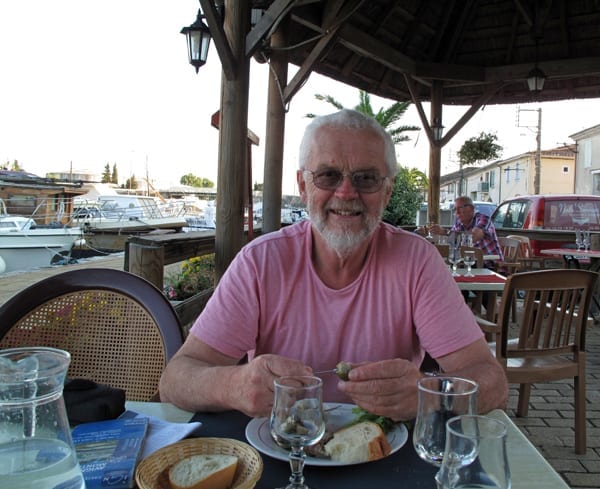
It turned out to be closed, but we noticed another one further along, le Clément IV, which had a flowery terrace right next to the water, where the pleasure boats were tied up in a row.
There was also an elegant-looking dining room across the road but we preferred the beauty of the canal, although it was getting cool.
Fortunately we had taken the precaution of bringing our jackets this time, after our sufferings the evening before.
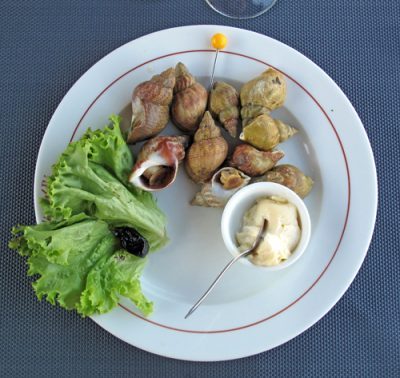
The menu was three courses for €13.50, remarkable value for such a fine place. We started with bulots – sea snails in garlic butter with a pot of aïoli – a suitably nautical dish, with which we consumed a whole basket of bread.
Then we had juicy pork steaks with little cubes of sautéed potatoes, and ended with a dish of coffee ice cream.
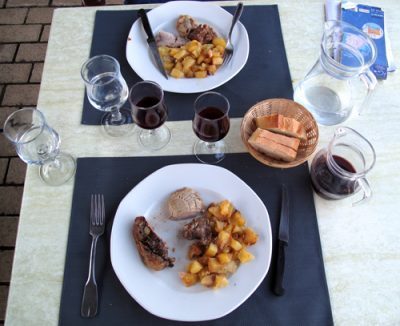
An enormously fat American woman made her way to our table and offered to take a photo of both of us. She said that they were staying at the Logis de France hotel and I airily replied that we were staying just around the corner. I did not think she needed to know that we were camping.
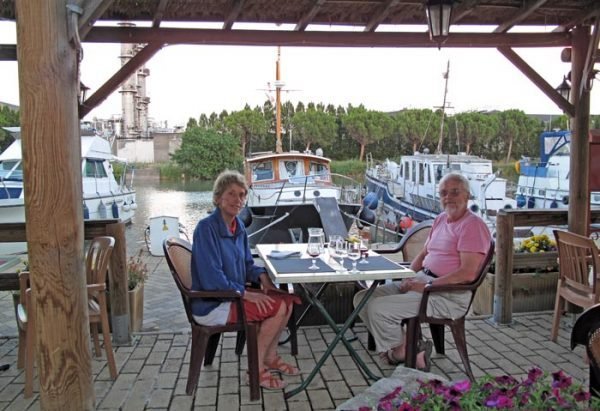
We could have had cups of coffee too, but it was getting cold as the light faded and we decided not to wait.
Previous day: St-Rémy-de-Provence to Fontvieille